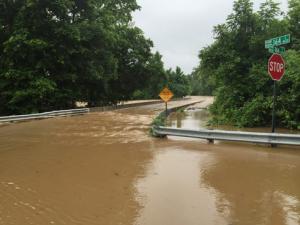DisastersRecord Missouri flooding was man-made calamity: Scientists
At the end of December 2015, a huge storm named “Goliath” dumped 9-10 inches of rain in a belt across the central United States, centered just southwest of St. Louis, most of it in a three-day downpour. The rain blanketed the Meramec Basin, an area of 4,000 square miles drained by the Meramec River, which enters the Mississippi River south of St. Louis. Why was the flooding so bad? Most news reports blamed it on the heavy rain, but researcher say there was more to the flood than the rain.

Missouri road inundated by floodwaters // Source: weather.gov
At the end of December 2015, a huge storm named “Goliath” dumped 9-10 inches of rain in a belt across the central United States, centered just southwest of St. Louis, most of it in a three-day downpour.
The rain blanketed the Meramec Basin, an area of 4,000 square miles drained by the Meramec River, which enters the Mississippi River south of St. Louis. The Meramec’s response was dramatic. Gauging stations recorded a pulse of water that grew as it traveled down the main stem of the Meramec River, setting all-time record highs in the lower basin in the Missouri cities of Eureka, Valley Park and Arnold.
While extraordinary rain drenched the entire Meramec Basin, only 5 percent of the Mississippi River’s giant watershed above St. Louis was so affected. Yet only a day after the flood on the lower Meramec peaked, water levels on the Mississippi at St. Louis were the third-highest ever recorded. A few days later, record flood stages were recorded downstream at Cape Girardeau, Mo., and Thebes, Illinois.
Why was the flooding so bad? Most news reports blamed it on the heavy rain, but Robert Criss, PhD, professor of earth and planetary sciences in Arts & Sciences at Washington University in St. Louis, said there was more to the flood than the rain.
“I think there was significant magnification of the flood levels on the Meramec by recent developments near the river,” he said. “Sure it rained a lot, but what happened here cannot be explained by the rainfall alone.”
The flood on the middle Mississippi River, in turn, was remarkable for its short duration and the time of year. “It was essentially a winter flash flood on a continental-scale river,” Criss said. “The Mississippi has been so channelized and leveed close to St. Louis that it now responds like a much smaller river.”
WUSTL reports that in the February issue of the Journal of Earth Science, Criss and visiting scholar Mingming Luo of the China University of Geosciences in Wuhan, China, take a close look at data for the New Year’s flood, treating it as a giant natural experiment that allowed them to test their understanding of changing river dynamics.
“Flooding is becoming more chaotic and unpredictable, more frequent and more severe,” Criss said. “Additional changes to this overbuilt river system will only aggravate flooding.
